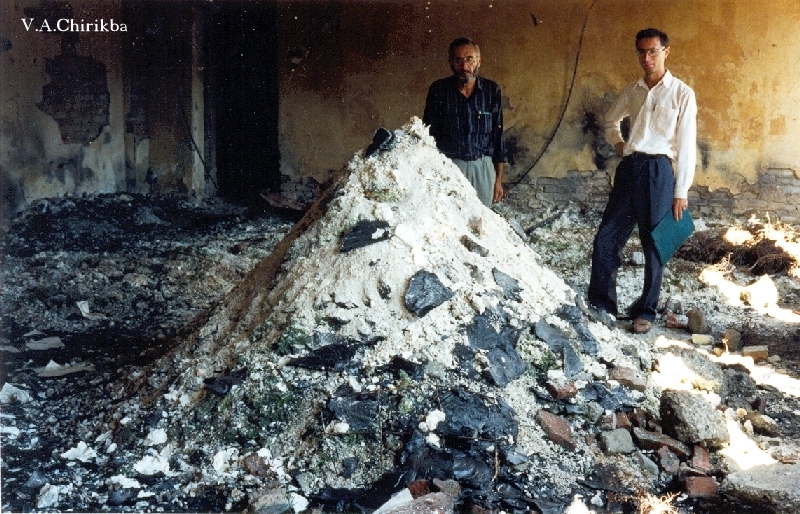The Day Abkhazia’s Documentary History Burned by Georgian Forces

Library director Boris Cholaria in front of the burned books.
SUKHUM / AQW'A ― Today, 22 October 2024, marks 32 years since the deliberate burning of the National Archives and National Library of Abkhazia by Georgian forces during the Georgian-Abkhazian War of 1992-93. On this day in 1992, in the heart of Sukhum, these two institutions, which held invaluable historical records and literary treasures, were set ablaze. This act, aimed at erasing Abkhazia’s documented heritage, destroyed nearly 95% of the archives, including an extensive collection dating back to the 19th century. Among the few surviving remnants was a radio archive from the 1930s, making the scale of the loss even more profound.
For the National Library of Abkhazia, the war's aftermath was equally bleak. Boris Cholaria, the Library director, noted the profound losses. From a pre-war status of 421 operational libraries boasting a stock of 7.5 million books, only five survived at the war's end. Almost 40% of this precious collection had been burned. Rare editions, some 6,000 volumes that chronicled Abkhazia's unique history, were entirely lost. Even the card-catalogues, which could have provided a reference to the lost volumes, did not survive.
Losses of the Central State Archive
All archival materials and collections, books, and newspapers published in Abkhazia from the second half of the 19th century were destroyed.
The ancient period's collections comprised around 17,000 storage units. These materials reflected the history of Abkhazia's annexation by the Russian Empire, agrarian issues, peasant uprisings, the state of agriculture, public education and healthcare, the customs and traditions of the Abkhaz people, the activities of religious institutions within the Sukhum district and the Black Sea Governorate, as well as the cultivation of tobacco, tropical, subtropical, and other crops in Abkhazia.
The entire Soviet-era archive collection of Abkhazia, along with materials from the Great Patriotic War (WW2), was destroyed in the fire.

Ermolay Adzhindzhal and Abesalom Lepsaya in front of the archives turned to ashes. Photo by Viacheslav Chirikba
+ 22 October 1992: Burning of the National Archives and Library of Abkhazia by the Georgian invaders
+ A history erased - Abkhazia's archive: fire of war, ashes of history
+ Vandals of the end of the XXth century, by Ermolay K. Adzhindzhal
+ Interview with Boris Cholaria, Director of the National Library of the Republic of Abkhazia
+ History on fire: how to restore the state-archive of Abkhazia

Losses of the Dmitry Gulia Abkhaz Institute of Language, Literature, and History
The fire destroyed the Atlas by Dubois de Montpereux (Paris, 1837), academician N. Y. Marr’s works on the language and history of the Abkhaz people, the 12-volume edition Acts of the Caucasian Archaeographic Commission edited by academician Berger (Tiflis, 1866-1904), and many other publications. A vast number of dictionaries, literature on archaeology, ethnography, history, and philosophy were lost—altogether about 150,000 editions—including all works in the Abkhaz and Georgian languages.
The institute’s newspaper collection, containing newspapers published in Abkhazia since 1917, was also consumed by the flames. Personal archives of Abkhaz scholars, including historian G. A. Dzidzaria, Sh. D. Inal-Ipa, archaeologists M. M. Trapsha and L. N. Solovyov, linguist K. S. Shakryl, and ethnographers I. A. Adzhindzhal, T. N. Bzhania, and many others, were also lost.
Among the losses were documents detailing around 45 Greek communities in Abkhazia, including the only complete set of the Pontic Greek newspaper Kokinos Kapnas. Additionally, the archive held valuable records concerning the Estonian community in Abkhazia, all of which were tragically destroyed.
Unique archaeological materials, more than 90 boxes, containing tens of thousands of items were destroyed. These included artefacts from the largest (over 500 tombs) excavated necropolis in Western Transcaucasia near the fortress of Tsibilium (Tsebelda), dating back to the 2nd-7th centuries AD. Among the losses were over 200 restored and intact ceramic vessels, a variety of weaponry, tools, several dozen unique examples of Syrian, Egyptian, and Western European glassware from the 1st-6th centuries AD, over 30 Roman and Byzantine silver and copper coins, and hundreds of items of gold, silver, bronze, and iron clothing accessories (clasps, buckles, earrings, brooches, etc.). A unique collection containing more than 50 Venetian glass vessels was also destroyed.
Not Everything Was Lost
Before the Patriotic War (Georgian-Abkhazian War of 1992-93) of the People of Abkhazia, the most valuable documents were not solely preserved on paper. Microfilms and photocopies were created and stored on tapes in buildings near the archive that were untouched by fire. The contents of these tapes are read with special equipment. After decoding, the materials are scanned, and the restored photo films are kept in special boxes in a separate room where the required temperature is maintained. The radio-archive from the 1930s was among the few remnants that survived this catastrophe. Additionally, some archival documents were published in collections before August 1992, preserving them from destruction.